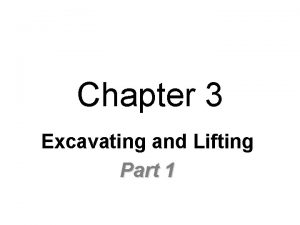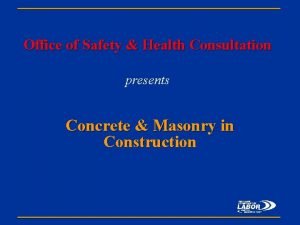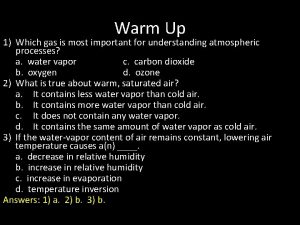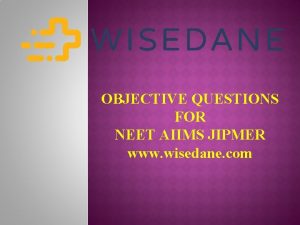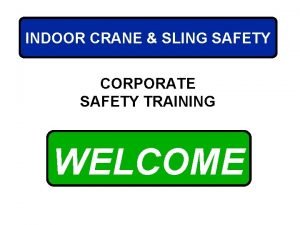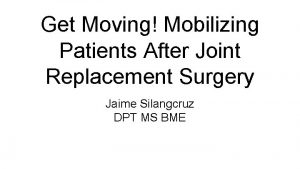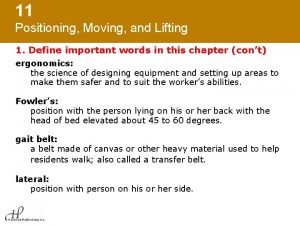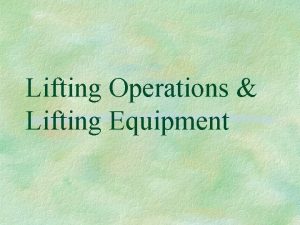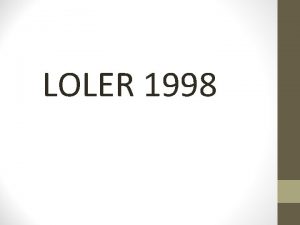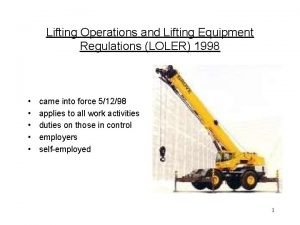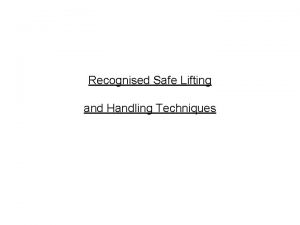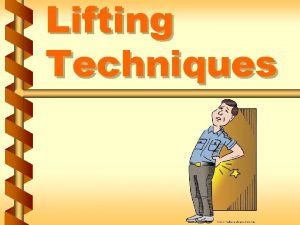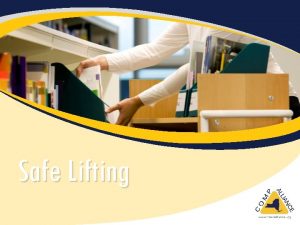Changes to S 2 Lifting Equipment Changes to











- Slides: 11

Changes to S 2: Lifting Equipment Changes to Section 18. 5 — Lifting Equipment Ron Macklin (Applied Materials) Lifting Equipment TF Chair July 12, 2006 SEMICON West 2006 - STEP Changes to SEMI S 2, Moscone Center, San Francisco

What has Changed between S 2 -0703 and Now (S 2 -0706) • Overview — Why did we make changes? – Users, Suppliers, and Evaluators expressed the need to have a more consistent approach to the design of lifting equipment. • Requirements varied; sometimes by region • Evaluators struggled with all the various and sometimes conflicting requirements. • Replaced a single statement with “minimum” set of design criteria addressing key elements involved in the design of lifting equipment. 2 July 12, 2006 SEMICON West 2006 - STEP Changes to SEMI S 2, Moscone Center, San Francisco

General Information • Six new definitions — Lifting equipment, device, fixture, and accessory; Yield Strength, and Placed on the Market • Use Parameters — Section 18. 5 pertains only to Maintenance and Service of the SME • Updated information concerning lifting equipment and user documentation (section 9. 6. 3) 3 July 12, 2006 SEMICON West 2006 - STEP Changes to SEMI S 2, Moscone Center, San Francisco

Design Criteria • Minimum Safety Factor (FS) has been established for lifting equipment • “Least favorable condition” — …the position or orientation of fixed or movable elements resulting in the greatest stress… “stress on component” = (least favorable condition X maximum “intended” load) • Note 86 — highlights additional safety factors required by codes, laws, and regulations… for items like slings, hoist rings, and lifting eyes — Understand the requirements fully! 4 July 12, 2006 SEMICON West 2006 - STEP Changes to SEMI S 2, Moscone Center, San Francisco

Design Verification • Testing and documentation requirements have been established and should include: – “Classical Engineering Calculations” (i. e. , what your assumptions are based upon) – “Risk Assessment” (i. e. , how have you identified ‘high risk’ or ‘potential problem’ areas AND what steps have been taken to remove, reduce or otherwise mitigate potential mishaps) – “Physical Testing” • Initial device of its kind or a representative sample (i. e. , applying section 18. 5 to an existing design or where changes are being made to an existing design) • Validates that the equipment will meet the requirements of this section and performs as it was intended (expected). 5 July 12, 2006 SEMICON West 2006 - STEP Changes to SEMI S 2, Moscone Center, San Francisco

Design Validation (Records) • Documentation Requirements: – Proper records (written reports, photos or drawings) should be prepared and maintained • Typically a minimum of 10 Yrs from being placed on market • Note 87: may require longer record retention requirements “…beyond last unit produced…” – Conformance to these criterion by the supplier can be demonstrated by: • Providing supporting documentation to an Assessor And; • Demonstrating that the supplier have taken steps to support the documentation retention requirements of this section. 6 July 12, 2006 SEMICON West 2006 - STEP Changes to SEMI S 2, Moscone Center, San Francisco

Subsequently Produced Equipment • Each individual piece of lifting equipment should have testing and record keeping requirements defined in accordance with 18. 5. 3. 1 (static testing) & 18. 5. 3. 2 (dynamic testing) • Test Certificates to accompany ALL equipment upon delivery. – Supplier should maintain copies of test records for a minimum of 10 years from date of shipment. 7 July 12, 2006 SEMICON West 2006 - STEP Changes to SEMI S 2, Moscone Center, San Francisco

Testing and Acceptance Criteria • Static load test: 150% of rated load – Test to be conducted with mechanical elements in their “least favorable” condition. • Dynamic load test: 110% of rated load – Also tested in its “least favorable” condition. – Conducted to verify proper assembly – May NOT be required in some cases • No dynamic elements i. e. , “spreader bar” • Not required if the anticipated “cyclic loading” is not expected to be above 20 K cycles for the life of the fixture or accessory • Acceptance Criteria: – No noticeable signs of improper; assembly, noise, operation or improper adjustments, or signs of excessive wear. – All safety features are fully operational and work. – No permanent set (yielding) of an mechanical or structural member. 8 July 12, 2006 SEMICON West 2006 - STEP Changes to SEMI S 2, Moscone Center, San Francisco

Marking Criteria • Lifting equipment should be clearly marked in a lasting, legible manner AND on a portion of the equipment that cannot be removed • No conflicting marks should be present (i. e. , no conflicting “information” that would call into question the use of said equipment) • Working (rated) load should be clearly visible from floor or working level • Minimum information to be conveyed; – Name and address of manufacturer, or registered trade mark, working (rated) load, date of construction and initial testing of that unit, and serial number, if any 9 July 12, 2006 SEMICON West 2006 - STEP Changes to SEMI S 2, Moscone Center, San Francisco

Marking (additional information) • Beyond the minimum requirements… – Note 92: highlights additional information required depending on equipment type (e. g. , hoist, slings, and accessories)… This includes markings based upon directives or regional requirements • The supplier is responsible for ensuring all marking requirements are met – In some cases the supplier may not be the “manufacturer”; in such case the supplier should be clear with regards to how equipment is to be marked (to meet this section). 10 July 12, 2006 SEMICON West 2006 - STEP Changes to SEMI S 2, Moscone Center, San Francisco

Ergonomic Considerations • Lifting equipment should conform to SEMI S 8 where applicable – Guidance concerning use of handles as opposed to using the load itself as a handle… • Identify handles or coupling points for manually driven axes – Handles or coupling points should be provided for lifting equipment positioned manually • Handles should not “promote” awkward postures 11 July 12, 2006 SEMICON West 2006 - STEP Changes to SEMI S 2, Moscone Center, San Francisco
 Lifting tools and tackles list
Lifting tools and tackles list 6bcy
6bcy Elektrotechnisch materiaal
Elektrotechnisch materiaal Elizabeth mulroney
Elizabeth mulroney Examples of chemical changes
Examples of chemical changes The limited access zone of a masonry wall must be
The limited access zone of a masonry wall must be Orographic lifting
Orographic lifting Convergent lifting
Convergent lifting A pump of 200w power is lifting 2kg water
A pump of 200w power is lifting 2kg water Slings safety training
Slings safety training No bending lifting twisting
No bending lifting twisting Transfer belt definition
Transfer belt definition

